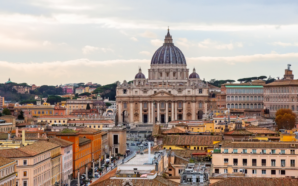The usual: frantic drivers, occasional bouts of organization, and endless streams of tourists and pilgrims; the welcome: temperate weather in sharp contrast with last year’s debilitating heat and old friends re-connecting; the Synod mood: a potpourri of caution, anxiety, hope and wild expectation.
On the same day that the Synod formally opened with a solemn pontifical Mass, with several thousands in attendance, a small group of women, including representatives from CNWE, the Canadian Network for Women’s Equality, staged a gentle, humour-laced and earnest demonstration on the Lungotevere Costello near the Castel Sant’Angelo, variously a papal citadel, residence and prison, stating their opposition to the exclusion of women from ordained ministry—diaconal and presbyteral.
While watching the protestors kick their vati-cans, I noticed two young cassock-wearing clerics walk by them with studied indifference, if not a smirk of condescension.
And that is clerical Rome.
Many Catholics, including a significant number of the synod-delegates or voting members, were dismayed when the decision was made to re-direct the issue of holy orders and women to one of the pope’s 10 Study Groups for further examination. In addition, the Dicastery for the Doctrine of the Faith has been charged to prepare a document for Francis on the basis of the Study Group’s exploratory work but has already indicated “that there is no room for a positive decision by the Magesterium regarding the access of women to the diaconate, understood as a degree of the Sacrament of Holy Orders.” And yet strangely, perhaps as a conciliatory gesture or as a benign stalling tactic, the Study Group report observes that “the Dicastery judges that the opportunity to continue the work of an in-depth study remains open.”
In part, this thinking is driven by the perception that women qua women exercise power differently than men and to that end the Dicastery will study the lives of great women of the church to ascertain their spiritual modus operandi without benefit of holy orders.
The list includes: Matilda of Canossa; Hildegard of Bingen; Bridget of Sweden; Catherine of Siena; Joan of Arc; Teresa of Avila; Juana Inés de la Cruz; Mama Antula; Elizabeth Ann Seton; Dorothy Day; Madeline Delbrél; Armida Barelli; and Maria Montessori.
All eminent; all securely dead.
Missing from the list—and, of course, no list could possibly be exhaustive—are Julian of Norwich, who often addressed God in feminine terms, and Thérèse de Lisieux, who actually yearned to be a priest.
The question about women and ministry cannot be decided by the Synod, whose function is essentially advisory to the pontiff, but it can serve as a forum, a platform, an environment of respectful dialogue, intense listening and mature discernment. Those qualities, much in evidence last year, need to bear fruit, to produce results that are not enshrouded in secrecy nor motivated by fear.
That takes courage and it takes trust.
Timothy Radcliffe, the Dominican author and one of the two spiritual guides to the synod delegates, spoke frankly about the challenges they face, that we face as a church, and asked at the end of one of his meditations: “What new ministries are needed for the church to recognize their authority and commission them to exercise it? The Gospel sheds light on so many who acted with authority in that time [including Mary Magdalene, the Apostle to the Apostles]. May we do so today.”
Radcliffe is not staking out a position; he is securing a portal. That is his irenic way.
But I wonder if ordination is not premature when we still have to address, as Bishop De Smedt of Bruges once called it, the “curse of clericalism.”
Michael’s new book The Jesuit Disruptor: A Personal Portrait of Pope Francis (House of Anansi, Sept. 2024) can be purchased through Amazon Australia.
Dr. Michael W. Higgins has been involved with investigating and expanding the Catholic Intellectual Tradition, particularly in Canada, for over forty years. Dr. Higgins is the Basilian Distinguished Fellow of Contemporary Catholic Thought at the University of St. Michael’s College in Toronto.
With thanks to Pontifex Minimus.
Pontifex Minimus is written on the ancestral territories of the Haudenosaunee, Anishinabewaki, Attiwonderonk and Mississaugas of the Credit First Nation peoples, who have stewarded these lands since time immemorial.








